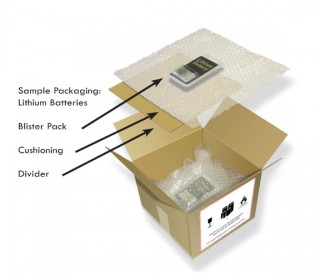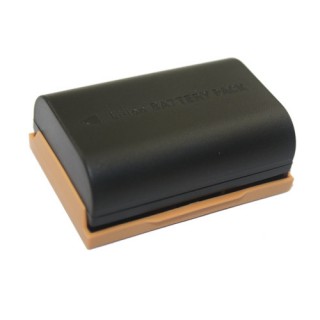Lithium batteries are defined in international regulations and by many transport companies as a hazardous material (HazMat). This applies to both Lithium Metal batteries (disposable) and Lithium Ion batteries (rechargeable), even though the latter do not actually contain lithium. The restrictions apply not strictly because of the lithium content, but because of the battery design which can provide high amounts of energy in a short period. This characteristic means that should the battery short out, it could generate excessive heat, causing it or nearby materials to catch fire.
Such events are extremely rare, but they do occur, especially with abused batteries (damaged or incorrectly charged) or those with low quality manufacturing processes (see Safety Issues with Lithium Batteries)
*Note – this article does not cover restrictions when you yourself are traveling with lithium batteries. In this case, there are certain limitations when flying – see Air Travel with Lithium Batteries.
Bullet Point Summary
The bullet points here are covered in more detail in the article below, but are a summary of checks you should carry out before you attempt to ship lithium batteries.
- Have the cells or batteries passed the tests laid out in the UNECE Manual of Tests and Criteria , Part III, sub-section 38.3?
- Do the cells or batteries meet the criteria of the UNECE Transport of Dangerous Goods Model Regulations?
- Have you packaged the battery correctly?
- If shipping by air, have you labelled the package correctly according to the Packaging Instructions for the appropriate UN number?
- If shipping by ground, have you checked with the carrier for any specific policies they have in place?
International regulations defining a lithium battery
At an international level, the United Nations Economic Commission for Europe (UNECE) defined all lithium batteries as ‘Dangerous Goods’ in December 2010 and ever tighter restrictions in what can and can’t be shipped and how it should be shipped have followed ever since.
In the first instance, lithium cells or batteries must pass a host of tests laid out in the Manual of Tests and Criteria , Part III, sub-section 38.3 ( https://www.unece.org/fileadmin/DAM/trans/danger/publi/manual/Rev5/English/03en_part3.pdf ), known as the ‘T tests’. They cover reaction to altitude, heat, vibration, shock, external short circuit, impact, overcharging and forced discharge.
Secondly, the UNECE notes ( http://www.unece.org/fileadmin/DAM/trans/danger/publi/unrec/rev17/English/Rev17_Volume1.pdf ) that any cell or battery must:
- meet certain structural requirements, such as ‘an effective means of preventing external short circuits’. Example – a Positive Temperature Coefficient. (see Safety issues with lithium batteries for a full description of various safety devices with lithium batteries).
- have been produced in a factory with certain processes in place such as ‘Quality records, inspection reports, test data, calibration data and certificates’ and ‘Management reviews to ensure the effective operation of the quality management program’ among others.
*Note – damaged or faulty batteries or those being sent for testing are therefore not covered and have their own rules which are beyond the scope of this article.
Finally, batteries and cells are categorized by the UNECE by how they will be shipped:
- UN 3090 – loose lithium metal batteries (not contained in, or packed with, equipment)
- UN 3091 – lithium metal batteries packed with equipment
- UN 3091 – lithium metal batteries contained in equipment
- UN 3480 – loose lithium-ion batteries (not contained in, or packed with, equipment)
- UN 3481 – lithium-ion batteries packed with equipment
- UN 3481 – lithium-ion batteries contained in equipment
These UN numbers form the cornerstone for how transportation organizations and companies define their regulations.
Regulations for shipping lithium batteries by air, sea or land.
The following bodies define rules and regulations of lithium batteries (as defined in the UNECE rules above)
- By air – the International Air Transport Association (IATA) via their Dangerous Goods Regulations (DGR) which categorizes lithium batteries as ‘Class 9 – Miscellaneous dangerous goods’.
- By Sea – the International Maritime Organization (IMO) via their International Maritime Dangerous Goods (IMDG) Code
- By Land
- In Europe – the European Commission (EC) via their international transport of dangerous goods on land regulations.
- In the US – the Department of Transport (DOT) via their transportation of lithium batteries rules
Your liability when shipping lithium batteries
As a party attempting to ship lithium batteries, it is your responsibility to carry out some level of due diligence regarding the items you wish to send. While it would be unreasonable to expect that you would visit the factory and inspect safety records, the more reputable manufacturers provide statements as to the processes they have in place.
These same manufacturers can provide data sheets detailing the construction of their batteries to satisfy you or the carrier that they meet the safety requirements needed in terms of their structure (e.g integrated safety vents, etc).
However, there are a large number of unbranded lithium battery products on the market, popular for their low prices, but with poor documentation and little information regarding how they are manufactured.
It is easy to see how you could get into trouble (legally and financially) if you were to ship unbranded batteries which caused a fire or damage. It would be easy to prove you had made no effort in meeting the legal criteria laid out by the governing bodies that enforce these rules. The batteries would have obviously not complied.
Do not underestimate your liabilities. IATA specifically states “Any person preparing or offering [lithium] cells or batteries for transport must receive adequate instruction on these requirements commensurate with their responsibilities” ( http://www.iata.org/html_email/CAR1001654/lithium_batteries.pdf ). This is clarified in the IATA Lithium Battery Guidance Document (Revised 9th March 2016) Part 2:C which sets out what this training should include and how it should be documented.
Prosecutions occur every year. In this 2011 example involving a truck with dangerous goods aboard a ferry in the United Kingdom, the driver was fined £4,000 and the transport company £18,000 for not complying with the rules.
Packaging loose lithium batteries for shipping


If the batteries you intend to ship are not installed within, or packed with the device they are meant to power, then they are defined as ‘loose’ – UN numbers UN 3090 and UN 3480 (see above). International regulations relate to air transport and are covered by IATA. However, if you are ground shipping, you should check with the carrier first to ensure you are aware of any specific requirements they may have regarding packaging.
This said, the IATA regulations (Lithium Battery Guidance Document 2016) are a solid template for all forms of transport and the key points are summarized below.
Isolate each cell or battery by completely enclosing it. A retail style blister pack would meet this requirement, but where this is not possible, wrapping the cell or battery in plastic is usually acceptable. Image 1 is an example provided by IATA on how the packaging should look in a box containing multiple batteries.
Protect the battery against short circuiting. The focus here is on the terminals, not only to avoid the possibility that they might bend and touch each other, but also that they cannot come into contact with any other material that could complete a circuit, such as a metal case or another battery’s terminals. The original manufacturer’s packaging, plastic baggy or covering is the best solution. In the absence of this, taping over and around the terminals with electrical insulating tape is an alternative.
Image 2 shows a lithium battery (in black) with a beige plastic clip-on cover to prevent the terminals coming into contact with each other or any external material.
The drop test. The packaging must be able to withstand a drop of 1.2 meters ( 4 feet ) without damaging the battery or any of the above systems of protection.
Labeling lithium batteries for air transport
As described above, the UNECE gives numbers to different types of lithium batteries (e.g. UN3091, UN3480, etc.) These are then assigned Packing Instruction numbers (e.g. PI968, PI970, etc.) by IATA, which lays out limits on what each package can contain and how it should be labelled.
*Note – “Packing Instructions” can be slightly misleading, as they detail the content limits of each package (numbers of batteries, power, etc.) and the way it is labelled, but not how the contents are packaged. See the section above for guidance in this area.
The UNECE and PI numbers are as follows
- UN 3090, PI968 – loose lithium metal batteries (not contained in, or packed with, equipment)
- UN 3091, PI969 – lithium metal batteries packed with equipment
- UN 3091, PI970 – lithium metal batteries contained in equipment
- UN 3480, PI965 – loose lithium-ion batteries (not contained in, or packed with, equipment) with a State of Charge of 30% or lower*
- UN 3481, PI966 – lithium-ion batteries packed with equipment
- UN 3481, PI967 – lithium-ion batteries contained in equipment
*Note – State of Charge is very difficult to measure in lithium batteries and relies on the complex, costly and time consuming Coulomb-counting technique. Factory fresh batteries from reputable manufacturers however, will be produced at the correct level, as they are aware of current shipping restrictions. Such manufacturers will be able to provide the required documentation.
The following link is to a pdf file containing two flow charts provided by the IATA regarding package size and labeling as of 9th March 2016. It is strongly recommended that you do not rely solely on this document, but also check for any recent updates.
The following subheadings breakdown this flowchart with links to examples of the appropriate labels and calculators.
UN 3090, PI968 – loose lithium metal batteries (not contained in, or packed with, equipment)
PI968: Section IA – where cells contain more than 1 gram of lithium or batteries contain more than 2 grams. (How to calculate lithium content)
- forbidden for transport as cargo on passenger aircraft
- labels: Cargo Aircraft Only and Class 9 label
- weight limit per package: 35kg
- number of packages: no limit
PI968: Section IB – where cells contain 1 gram or less of lithium or batteries contain 2 grams or less (High Volume shipping) (How to calculate lithium content)
- forbidden for transport as cargo on passenger aircraft
- labels: Cargo Aircraft Only and Class 9 label and Lithium Metal Battery Handling Label
- weight limit per package: 2.5kg
- number of packages: no limit
PI968: Section II – where cells contain 1 gram or less of lithium or batteries contain 2 grams or less (Low volume shipping) (How to calculate lithium content)
- forbidden for transport as cargo on passenger aircraft
- labels: Cargo Aircraft Only and Class 9 label and Lithium Metal Battery Handling Label
- weight limit per package: 2.5 kg where cells contain 0.3 grams or less of lithium, otherwise a maximum of 8 cells or two batteries. For larger packages use section IB above.
- number of packages: one. For more than one package use section IB above.
UN 3091, PI969 – lithium metal batteries packed with equipment
PI969: Section I – where cells contain more than 1 gram of lithium or batteries contain more than 2 grams (How to calculate lithium content)
- labels: Class 9 label
- weight limit per package: 5kg when transported as cargo on passenger aircraft (Pax A/C), 35kg on Cargo Aircraft Only (CAO)
- number of packages: no limit
PI969: Section I – where cells contain 1 gram or less of lithium or batteries contain 2 grams or less (How to calculate lithium content)
- labels: Lithium Metal Battery Handling Label
- weight limit per package: 5kg when transported as cargo on passenger aircraft (Pax A/C) or on Cargo Aircraft Only (CAO)
- number of packages: no limit
UN 3091, PI970 – lithium metal batteries contained in equipment
PI969: Section I – where cells contain more than 1 gram of lithium or batteries contain more than 2 grams (How to calculate lithium content)
- labels: Class 9 label
- weight limit per package: 5kg when transported as cargo on passenger aircraft (Pax A/C), 35kg on Cargo Aircraft Only (CAO)
- number of packages: no limit
PI969: Section I – where cells contain 1 gram or less of lithium or batteries contain 2 grams or less (How to calculate lithium content)
- labels: Lithium Metal Battery Handling Label
- weight limit per package: 5kg when transported as cargo on passenger aircraft (Pax A/C) or on Cargo Aircraft Only (CAO)
- number of packages: no limit
UN 3480, PI965 – loose lithium-ion batteries (not contained in, or packed with, equipment)
PI965: Section IA – where cells greater than 20Wh or batteries greater than 100 Wh (How to calculate Wh)
- State of Charge must be < 30%
- forbidden for transport as cargo on passenger aircraft
- labels: Cargo Aircraft Only and Class 9 label
- weight limit per package: 35kg
- number of packages: no limit
PI965: Section IB – where cells equal to or less than 20Wh or batteries equal to or less than 100Wh (High Volume Shipping) (How to calculate Wh)
- State of Charge must be < 30%
- forbidden for transport as cargo on passenger aircraft
- labels: Cargo Aircraft Only and Class 9 label and Lithium-ion Battery Handling Label
- weight limit per package: 10kg
- number of packages: no limit
PI965: Section II – where cells equal to or less than 20Wh or batteries equal to or less than 100Wh (Low Volume Shipping) (How to calculate Wh)
- State of Charge must be < 30%
- forbidden for transport as cargo on passenger aircraft
- labels: Cargo Aircraft Only and Class 9 label and Lithium-ion Battery Handling Label
- weight limit per package: where individual cells are less than or equal to 2.7Wh the weight limit is 2.5kg. Above this the limit is 8 cells or two batteries. For larger packages use section IB above.
- number of packages: one. For more than one package use section IB above.
UN 3481, PI966 – lithium-ion batteries packed with equipment
PI966: Section I – where cells greater than 20Wh or batteries greater than 100 Wh (How to calculate Wh)
- labels: Class 9 label
- weight limit per package: 5kg when transported as cargo on passenger aircraft (Pax A/C), 35kg on Cargo Aircraft Only (CAO)
- number of packages: no limit
PI969: Section II – where cells equal to or less than 20Wh or batteries equal to or less than 100Wh (How to calculate Wh)
- labels: Lithium-ion Battery Handling Label
- weight limit per package: 5kg when transported as cargo on passenger aircraft (Pax A/C) or on Cargo Aircraft Only (CAO)
- number of packages: no limit
UN 3481, PI967 – lithium-ion batteries packed with equipment
PI967: Section I – where cells greater than 20Wh or batteries greater than 100 Wh (How to calculate Wh)
- labels: Class 9 label
- weight limit per package: 5kg when transported as cargo on passenger aircraft (Pax A/C), 35kg on Cargo Aircraft Only (CAO)
- number of packages: no limit
PI967: Section II – where cells equal to or less than 20Wh or batteries equal to or less than 100Wh (How to calculate Wh)
- labels: Lithium-ion Battery Handling Label
- weight limit per package: 5kg when transported as cargo on passenger aircraft (Pax A/C) or on Cargo Aircraft Only (CAO)
- number of packages: no limit
Labeling lithium batteries for ground/sea transport
Lithium batteries are classified internationally as a class 9 hazardous material and so require the Class 9 label and the appropriate Lithium-ion Battery Handling Label or Lithium Metal Battery Handling Label.
Restrictions by individual carriers
Further, certain carriers have their own restrictions. UPS and Fedex, for example, will only accept lithium batteries from “pre-approved customers”.
In general, shipping companies have tended to create restrictions which are above and beyond those officially recommended. DHL, for example, will not accept any loose lithium batteries. Often this is because the shipper might use a mix of cargo on passenger planes and cargo only aircraft to meet delivery deadlines and optimize costs. Sorting parcels to separate out those containing lithium batteries suitable for cargo only planes would cause delays and increase costs.
As such, always check with your carrier for details of their individual requirements before attempting to ship. Links to the leading US carriers are:
- UPS – https://www.ups.com/media/news/en/ca/intl_lithium_battery_regulations.pdf
- FEDEX – http://images.fedex.com/us/services/pdf/LithiumBattery_Overview.pdf
- DHL – http://www.dhl.com.pl/en/express/shipping/shipping_advice/lithium_batteries.html
References:
Note the IATA offers a comprehensive manual dedicated to Lithium Batteries which can be purchased here: http://www.iata.org/publications/Pages/lithium-battery-guidelines.aspx


Leave A Comment?